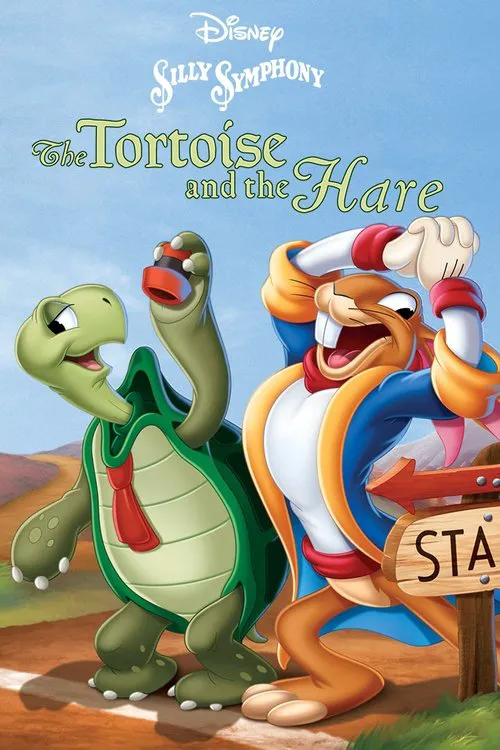The Tortoise and the Hare

Plot
In the early 1930s, Walt Disney was on the rise, establishing himself as a prominent figure in the world of animation. His studio, Disney Brothers Cartoon Studio, had already gained widespread recognition with the creation of Oswald the Lucky Rabbit, a character he had created for Universal Pictures. Unfortunately, due to a contract dispute, Disney lost the rights to Oswald, which prompted him to create a new character, Mickey Mouse. The massive success of Mickey Mouse catapulted Disney's studio to new heights, and the demand for more content was on the horizon. Disney knew he had to keep momentum going, hence he turned his attention to classical literature for inspiration. He became fascinated with the works of Aesop, an ancient Greek storyteller renowned for his fables that conveyed moral lessons through engaging narratives. Among Aesop's most celebrated stories was the timeless classic "The Tortoise and the Hare," which tells the tale of a speedy rabbit who takes a nap and ultimately falls short of winning a race against a slow but relentless tortoise. Given Disney's track record with adapting children's literature into animated shorts, Wilfred Jackson, the director, saw the untapped potential in "The Tortoise and the Hare." The team aimed to deliver a story that not only adhered to Aesop's original message but also showcased the humor, charm, and whimsy that had become synonymous with Disney's works. The story begins with an introduction to the Hare, a boastful and arrogant character who takes great pride in his exceptional speed. He boasts to the other forest creatures about his impressive running abilities, proclaiming that he is the fastest animal in the forest. The Hare is particularly dismissive of the Tortoise, labeling him as "slow and clumsy." This prompts the other animals to place a wager: if the Hare can win a race against the Tortoise, the winner will receive a golden carrot. As the day of the big event arrives, the Hare becomes increasingly confident. He starts the race with a strong lead, but as the distance between him and the Tortoise elongates, the Hare becomes complacent, assuming victory is a foregone conclusion. The Hare takes a leisurely stroll, pausing to enjoy a picnic lunch along the way. Meanwhile, the Tortoise, with an unyielding determination and a never-say-die attitude, continues running, albeit at a snail's pace. The tables eventually turn as the Hare becomes lethargic from his extended break. He wakes up just in time to find that the Tortoise is mere feet away from finishing the remaining distance of the track. The Hare frantically tries to accelerate, but it's too late; the tortoise crosses the finish line first, much to the surprise and dismay of the Hare, and even some of the other forest animals who believed the Hare to be a shoo-in for the win. In the end, the Hare's excessive pride and underestimation of the Tortoise ultimately led to his downfall. The story is a testament to the age-old adage "pride comes before a fall," emphasizing that arrogance can lead to one's own demise, and that perseverance and hard work often yield greater rewards. The animation in "The Tortoise and the Hare" features a range of visual styles that add to the cartoon's charm. Walt Disney was known for his innovative approach to animation, and in this particular short film, Wilfred Jackson brings that vision to life. The Hare is depicted as a comically exaggerated version of himself, with an exaggerated grin and expressive facial features that perfectly capture his boastful and self-assured personality. "The Tortoise and the Hare" marks an important milestone in Disney's illustrious career. Not only did it solidify his reputation as a master storyteller, but it also showcased his ability to adapt timeless classics for a global audience. Moreover, the film's influence can be seen in later Disney cartoons, including the creation of Bugs Bunny, which shares a similar theme of an overconfident character facing their eventual downfall at the hands of a determined underdog. The Academy Award for Best Short Subject: Cartoons in 1935 was a testament to Disney's groundbreaking animation in "The Tortoise and the Hare." The cartoon's recognition not only validated Disney's creative vision but also acknowledged his dedication to pushing the boundaries of animation. In the end, "The Tortoise and the Hare" emerges as a timeless classic that continues to captivate audiences worldwide, reminding us that determination and effort are key factors in achieving success.
Reviews
Recommendations




